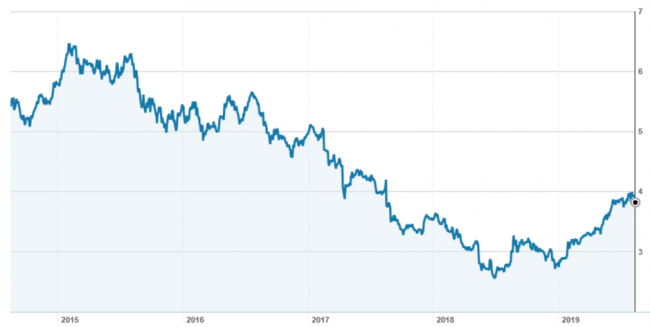The nicest thing I can say about Telstra is that it is probably better than its main competitors, Optus and Vodafone. Some would say that they are all hopeless, so this really doesn’t mean too much.
The second nicest thing I can say is that they are trying hard, and CEO Andy Penn and his leadership team might yet pull off the somewhat unimaginable and make up for the havoc the NBN is reeking on Telstra. But there is a long way to go on this front and Telstra remains very much a “work in progress”.
Last Thursday, Telstra broadly met market expectations when it reported NPAT for the year of $2.1bn (its worst financial result in 21 years.) Key numbers included:
- Revenue down 3.6% to $27.8bn;
- EBITDA down 21.7% to $8.0bn and underlying EBITDA down 11.2% to $7.8bn; and
- A full year dividend of 16c, fully franked (down from 22c in FY18).
Telstra has been one of the best performing stocks on the ASX this year. While it has been a big beneficiary of lower interest rates, the market has also taken a view that the worst is behind it. Its competitive position has been enhanced by the ACCC stopping the merger of competitors Vodafone and TPG, and TPG subsequently abandoning plans to build a fourth mobile network.
From a low of around $2.56 last June, Telstra has rallied to almost $4. On Friday, it closed at $3.77.
Telstra (TLS) – 8/14 – 8/19

The highlight of Telstra’s profit report was their guidance for next year (FY20) and a statement that underlying EBITDA, excluding NBN headwinds, could grow by up to $500m or almost 7%. Importantly, this compares to a decline of 4% this year (FY19).
But the headwinds from the NBN (which is the impact of Telstra’s transition from the national wholesale provider, and in the case of fixed broadband to becoming just a retailer) are expected to be between $800m and $1 billion in FY20. This means that Telstra’s EBITDA will decline again in in FY20 to a range of $7.3bn to $7.8bn (this compares to a proforma $8.2bn for FY19, after adjusting for a change in the accounting treatment of leases).
All up, the NBN is estimated to have already cost Telstra an annualised $1.7bn in earnings. Telstra says that it is about “half- way through”, so by the time the migration is complete, the negative recurring impact on Telstra’s EBITDA will be around $3.5bn. This is about $500m higher than previously estimated.
To mitigate against the impact of these NBN headwinds, Telstra has initiated a productivity and cost out program that is targeting an annualised $2.5bn saving in costs by FY22. It is roughly half-way through with savings of $1.17bn and says it is “on-track” for the target, but as the easy-wins become harder to find, this will require a lot of hard work to complete.
Revenue from mobiles rose very marginally due to equipment sales, but the ARPU (average revenue per user) fell from $56.22 per month in the second half of FY18 to $53.60 in the second half of FY19. Telstra expects this to fall further into FY20.
Bright spots included a net gain of 370,000 post-paid mobile customers, and a share of new NBN retail connections of 49%. The rollout of 5G services is progressing, with Telstra expecting to increase its coverage fivefold over the next 12 months. However, it still looks some way away from making any meaningful contribution to earnings.
What do the brokers say?
According to FN Arena, there are 2 buy recommendations, 3 neutral recommendations and 1 sell recommendation (see table below)n. Ord Minnett upgraded from neutral to accumulate following the result and raised its target price, citing that Telstra management has signalled lower capital intensity in the outer years post the NBN migration.
Credit Suisse also raised its target price, noting that Telstra has guided to lower than expected capex in FY 20 of $2.9bn to $3.3bn (compared to $4.1bn in FY19). The consensus broker target price is now $3.91, a small premium to Friday’s market price of $3.77.
The brokers have Telstra trading on a multipole of 19.4 times forecast FY20 earnings and 19.4 times FY21 earnings. They forecast total dividends of 16c in FY20 and the same again in FY21, putting Telstra on a yield of 4.2%.

The bottom line
Income investors should be able to take heart that the dividend of 16c per share looks fairly secure for the next couple of years. While the yield is of 4.2% is not outstanding, it is fully franked and grosses up to 6.0%. Given the outlook for interest rates, this makes it reasonably attractive.
Investors expecting Telstra to push back and stay over $4 will need to be convinced that leadership in 5G will quickly translate to the bottom line and that Telstra can complete its cost out program. My sense is that there are hard yards ahead for Telstra here.
Important: This content has been prepared without taking account of the objectives, financial situation or needs of any particular individual. It does not constitute formal advice. Consider the appropriateness of the information in regard to your circumstances.